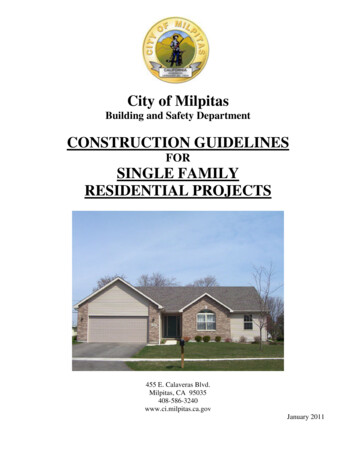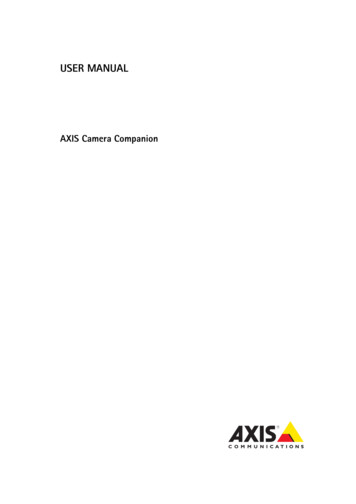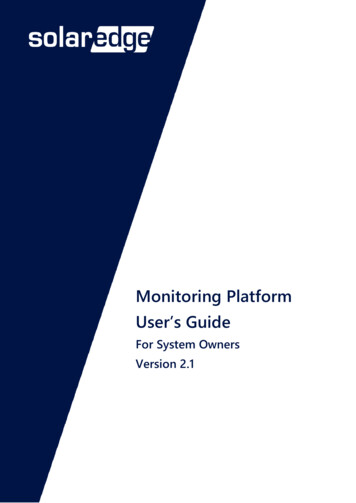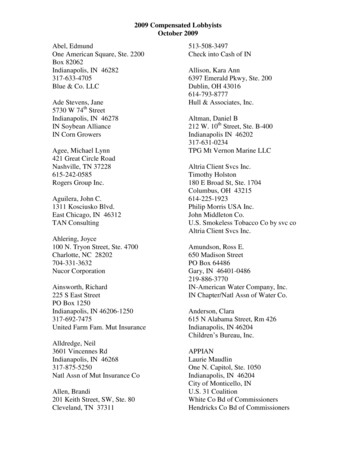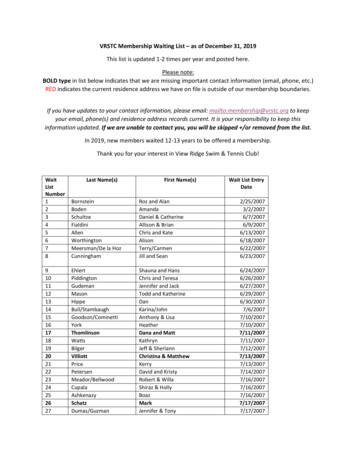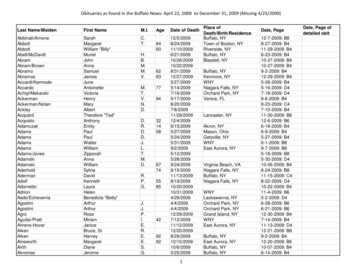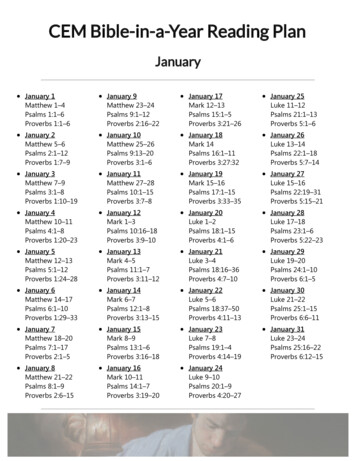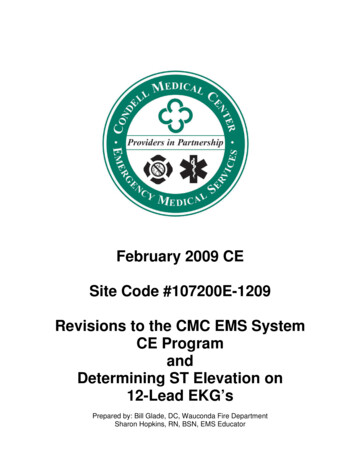
Transcription
February 2009 CESite Code #107200E-1209Revisions to the CMC EMS SystemCE ProgramandDetermining ST Elevation on12-Lead EKG’sPrepared by: Bill Glade, DC, Wauconda Fire DepartmentSharon Hopkins, RN, BSN, EMS Educator
Date of CE presentation: February 2009Topic: Overview of the Revised Condell EMS System CE and Determining ST Elevation on 12 leadEKG’sBehavioral Objectives:Upon successful completion of this module, the EMS provider will be able to:1. Identify the changes in the Condell EMS System CE program as taught in class.2. Identify the appropriate components of the cardiac conduction system with thecorrect wave form on a rhythm strip.3. Identify when it is appropriate to obtain a 12 lead EKG.4. Identify the criteria for significant ST elevation following guidelines reviewed in class.5. Identify EKG leads that view the anterior, inferior, lateral walls, and septum.6. Recognize the patterns of an MI after viewing the components of a 12 lead EKG.7. Identify typical and atypical presentations of an acute MI.8. Identify complications associated with an inferior wall MI.9. Identify complications associated with an anterior/septal wall MI.10. Identify complications associated with a lateral wall MI.11. Identify interventions for the complications of heart block, pulmonary edema, andcardiogenic shock.12. Identify the SOP guidelines for the patient presenting with acute coronarysyndrome as written in the Region X SOP’s.13. State dosing and precautions for Aspirin, Nitroglycerin, and Morphine.14. Identify ED staff expectations of EMS personnel when calling the hospital toreport a patient with ST elevation identified on a 12 lead EKG.15. Identify EMS expectations when delivering a patient to a hospital after STelevation has been identified on a 12 lead EKG.16. Actively participate in 12 lead EKG scenario practice and discussion.17.Given a picture, trace the order of the cardiac conduction system correctly.18. Given a manikin, correctly place electrode placement to obtain a 12 lead EKG.References: Aehlert, B. EKG’s Made Easy third Edition. Elsevier Mosby. 2006.Beasley, B. Understanding EKG’s A Practical Approach. Brady. 2003.Bledsoe, B., Porter, R., Cherry, R. Paramedic Care Principles and Practices. Third Edition. Brady.2009.Ellis, K. EKG Plain and Simple. Prentice Hall. 2002.Page, B. 12 Lead EKG for Acute and Critical Care Providers. Brady. 2005.Phalen, T., Aehlert, B. The 12 Lead EKG in Acute Coronary Syndromes. Second Edition, ElsevierMosby. 2006.Region X SOP’s. March 2007, Amended January 1, 2008.freemd.com (Acute Coronary Syndrome nu/ekg mi.htmFile: CE, EMS; CE Packets; 2009; Feb 2009 Cardiac CE Dept Obj 7 References ; Revised 2.6.09
Answers and in-depth information for the following 10 cases can be obtained from the accompanyingpower point program. The power point program is available through your department Medical Officer andvia the CMC EMS website at Condell.org/emergency/.12-Lead Electrode PlacementContiguous Leads Practice Identifying ST SegmentElevation 1mm (1 small box) above the baseline in 2 leadsfrom any group or 2 or more contiguous leads( 2 mm (2 small boxes) in limb leads consideredalternative elevation by some) measured 0.04seconds after J pointLateral wall: I, aVL, V5, V6Inferior wall: II, III, avFSeptum: V1 and V2Anterior wall: V3 and V4Posterior wall: V7-V9 (leads placedon the patient’s back 5th intercostalspace creating a 15 lead EKG)
Case #152 year-old patient complains of indigestion after pizza & beer dinner. VS: 124/82; P – 108; R - 18 Is there ST elevation: I, aVL, V5, V6? II, III, aVF? V1, V2? V3, V4? What are you going to do for this patient?
Case #2 62 year-old female developed chest & jaw pain while in the showerVS: 110/62; P – 66; R – 20Is there ST elevation: I, aVL, V5, V6? II, III, aVF? V1, V2? V3, V4?What are you going to do for this patient?
Case #3 45 year-old patient who complains of chest heaviness & lightheadednessVS: 90/56; P – 86; R - 22Is there ST elevation: I, aVL, V5, V6? II, III, aVF? V1, V2? V3, V4?What are you going to do for this patient?
Case #4 87 year-old female patient complains of dizziness and being extremely tiredVS: 88/52; P – 30; R - 16Is there ST elevation: I, aVL, V5, V6? II, III, aVF? V1, V2? V3, V4?What are you going to do for this patient?
Case #5 58 year-old male patient who complains of chest pain radiating down the left arm after working out in the gymVS: 110/72; P – 100; R - 18Is there ST elevation: I, aVL, V5, V6? II, III, aVF? V1, V2? V3, V4?What are you going to do for this patient?
Case #6 92 year-old patient complaining of pounding in her chest for one hourVS: 98/66; P – 110; R- 16Is there ST elevation: I, aVL, V5, V6? II, III, aVF? V1, V2? V3, V4?What are you going to do for this patient?
Case #7 66 year-old patient with history of diabetes for 25 years complains of being lightheaded and is sweatyIs there ST elevation: I, aVL, V5, V6? II, III, aVF? V1, V2? V3, V4?What are you going to do for this patient?
Case #8 70 year-old patient had a syncopal episode when they stood up from the couchVS: 156/98; P – 76; R - 16Is there ST elevation: I, aVL, V5, V6? II, III, aVF? V1, V2? V3, V4?What are you going to do for this patient?
Case #9 82 year-old patient complains of sudden onset of slurred speech, inability to grasp a coffee cup, and inability to follow simple commandsVS: 122/84; P – 110; R - 18Is there ST elevation: I, aVL, V5, V6? II, III, aVF? V1, V2? V3, V4?What are you going to do for this patient?
Case #10 36 year-old patient who passed out standing in line at a bankVS: 128/78; P – 80; R - 20Is there ST elevation: I, aVL, V5, V6? II, III, aVF? V1, V2? V3, V4?What are you going to do for this patient?
Identify EKG leads that view the anterior, inferior, lateral walls, and septum. 6. Recognize the patterns of an MI after viewing the components of a 12 lead EKG. 7. Identify typical and atypical presentations of an acute MI. . Ellis, K. EKG Plain and Simple. Prentice Hall. 2002. Page, B. 12 Lead EKG for Acute and Critical Care Providers .


